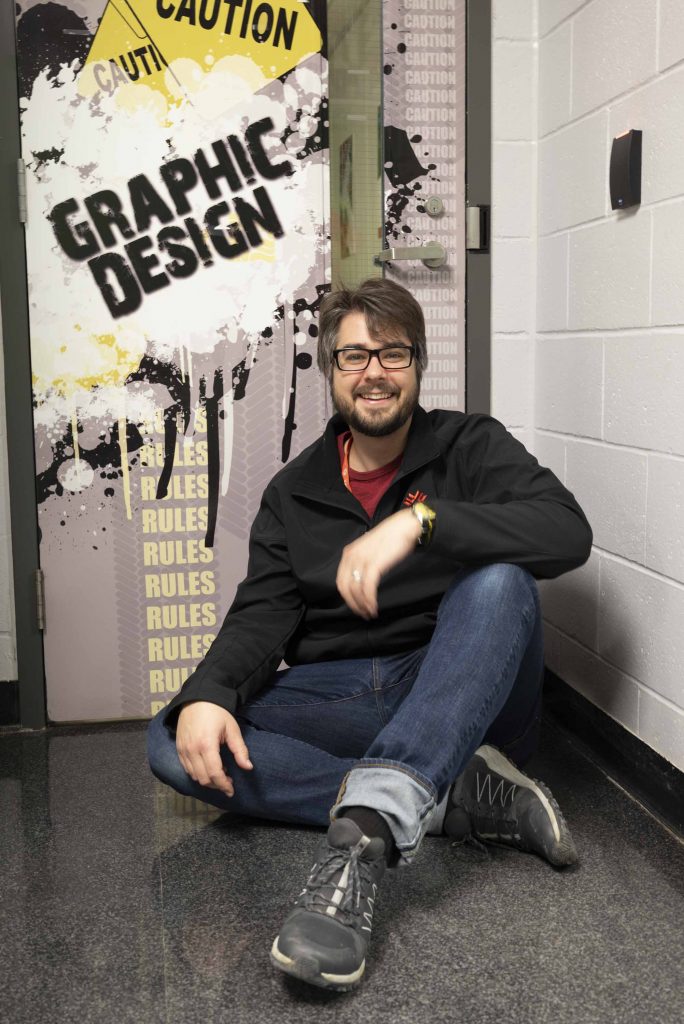Robert Armstrong
Role: Graphic Design

Describe your first introduction to the concept of OER? How has your understanding of Open Pedagogy changed by being part of a team advancing OER support?
Before starting work with the OER Design Studio, I understood the concept of open-source and collaborative free learning materials, but generally the idea of their use was for self-taught learning. Knowing that we can create quality and thorough learning materials that can be used in a classroom setting has opened my eyes to the possibilities of creating these materials for areas that don’t use traditional learning resources.
OER is not as complicated as it appears, especially when you have a team working alongside you to produce materials that are professional and inline with your educational goals. Being involved with OER can also be any part of the teaching process, as it doesn’t necessarily have to be the core teaching material. Anything can be OER, as long as it allows others to learn from it, share and adapt it for other uses. OER benefits from sharing, as ideas can flourish unencumbered from a “walled garden” that may prevent access and collaboration.
OER doesn’t suffer from the lack of quality or cohesiveness when assembled professionally by a team who has a focus on enhancing the quality of the materials and accessibility for students. Students benefit immensely by having access to content that can be updated constantly to reflect ever-changing aspects of the content as well as not being financially burdened by excessive textbook and resource fees. It also puts the institution in a positive light as it shows they care about student education and reinforces the positive student experience.
In your role identify ONE benefit and ONE challenge you experienced in the design/delivery process.
Benefits
Team collaboration is a great benefit. Being able to rely on other team members’ strengths in order to get a task complete is an invaluable asset. Having team members willing to help out and expand out of their comfort zone to assist is also a benefit that can’t be ignored.
Due to the pandemic, and work-from-home, you lose those in-person chats as you have to either schedule meetings over platforms like Zoom or WebEx, use email, or chat-style platforms like Microsoft Teams and Slack. As with anything regarding online communication, there are often points that are missed due to miss-communication.
Challenges
Challenges are learning new software and platforms in a short amount of time. While there are basic skills that can be transferred between platforms, every introduced piece has their own set of challenges that can take some time to debug or make work with existing platforms. Also can be a challenge when there is something new to implement in already established OERs that may cause a redesign or change of thought on how to present the information.
Accessibility considerations of graphics is also a big challenge, as creating graphics and illustrations requires thoughtful consideration of colours, specific typefaces and layout for ease-of-use. Quality control of graphics can be an issue too, with some Open Source content not being up to standards, so there has to be a re-creation or alteration of the existing materials. Copyright issues are also a big consideration, since we rely on open-source materials, and if they don’t exist, we’re tasked to create them.
Robert’s Technical Tips
 Focus on inclusive design from the start. Every graphic should focus on best practices for users in their viewing and interpretation of the graphic at hand. Colours should be accessible, type size and layouts should be done in a way to show a clear and concise message. When images are uploaded to the internet, making sure the use of Captions and Alt Tags are in place for screen readers and other accessibility platforms.
Focus on inclusive design from the start. Every graphic should focus on best practices for users in their viewing and interpretation of the graphic at hand. Colours should be accessible, type size and layouts should be done in a way to show a clear and concise message. When images are uploaded to the internet, making sure the use of Captions and Alt Tags are in place for screen readers and other accessibility platforms.- Communicating effectively with team members and OER authors. There can be some easy disconnect when working remotely, so having proper project management skills – organization, time management, communication (following up, asking questions, getting useful information.) When discussing graphic materials with the OER authors, they often are unfamiliar with what sort of content they can use, so knowing what questions to ask them in order to help them discover and pick out what graphics would be needed to help convey the content and explain it. Not just having images for the sake of it, but ones that help the reader understand and learn the content at hand.

